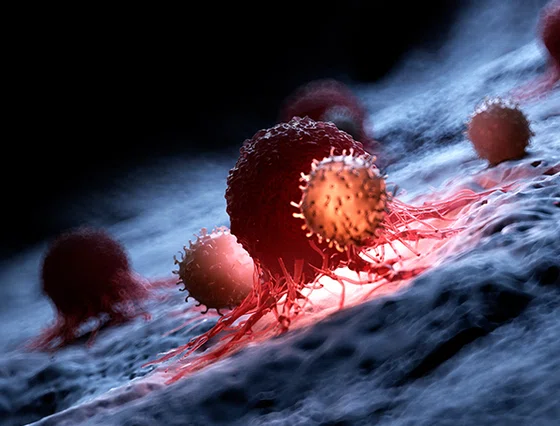


Precision Medicine
Researchers identify a novel immunotherapy target to combat glioblastomas
Much like Jackson Pollock’s paintings with splashes of different colors on a single canvas, cancers contain different flavors of tumor and normal cells mixed within a single mass. These heterogeneous cancers are notoriously difficult to manage since treatments that work against one group of tumor cells may be completely ineffective in others.
Advancing the search for targeted therapies for heterogeneous tumors, in a new study published in Nature Communications, Houston Methodist researchers have identified the genetic and molecular fingerprints of different cancer and immune cells in glioblastoma, the deadliest and most common type of brain cancer in adults.
Their in-depth molecular analysis of over 200,000 single cells revealed a protein, S100A4, that could be a potential therapeutic target for restoring antitumor action of immune cells toward glioblastomas that have otherwise beguiled the immune system into protecting it.
Around 48% of all primary malignant brain tumors are glioblastomas, and more than 10,000 people in the United States alone will succumb to the disease each year. The highly invasive brain cancer cells infiltrate the brain extensively, making surgical resection a very big challenge. Adding to the complexity of the disease is cancer’s ability to rapidly mutate, so even in a specific location in the brain, glioblastoma encompasses a mosaic of cancer cell types, posing a major setback for targeted therapies.
As in the case with most diseases affecting the brain, the blood-brain barrier poses another challenge for drug delivery. In glioblastoma, the blood-brain barrier is weakened, allowing immune cells from the periphery to permeate the central nervous system. Mysteriously, however, glioblastomas tend to selectively attract only those peripheral immune cells that promote their malignancy.
Immune cells positive for protein S100A4 (arrows) could be a potential therapeutic target for restoring the antitumor action of immune cells toward glioblastomas.
“A lot of immunotherapies currently target the reactivation of effector T cells, which are important to attack and eliminate cancer cells, but in glioblastoma, the effector T cell infiltration is, in fact, very low, and instead, there is an overabundance of immunosuppressive myeloid cells,” said Kyuson Yun, PhD, associate professor of Neurology and senior author on the study.
To investigate the complex immune-cancer cell interactions, the researchers conducted comprehensive genetic profiling of different cell types in 44 samples of glioblastoma from 18 patients. For each patient, they analyzed glioblastoma tissue from different parts of the brain tumor to gain insights into the cancer’s heterogeneity within each patient. Then, they performed high throughput single-cell RNA sequencing to catalog individual cells based on their gene expression of different molecules.
Single-cell sequencing allowed us to define the heterogeneous myeloid cell types and identify the molecular characteristics of immune cells that promote or suppress tumor growth and consequently allowed us to restore tumor-fighting action of the immune system.
Kyuson Yun, PhD
Associate Professor of Neurology
Houston Methodist
Upon grouping the cells based on their molecular profiles, the researchers found that glioblastomas within and across patients could be categorized into nine groups based on their cellular state, such as stemness and hypoxia, independent of the specific mutations in individual cells. Further, they also identified nine subtypes of myeloid cells in glioblastoma, including the brain’s macrophages, microglia, that are associated with better patient outcomes. The tumors were also replete with bone marrow-derived macrophages and regulatory T cells that are immunosuppressive but are linked with worse patient outcomes.
Hence, the researchers turned their attention to S100A4, a regulator protein produced and secreted by glioblastoma cancer cells, immunosuppressive T cells and bone marrow-derived myeloid cells. Their strategy was to spare “good” immune cells that are associated with better survival and selectively target “bad” immune cells that promote tumor growth and immune evasion.
The team used genetically engineered knockout mice that do not express the S100A4 gene. When these animals were injected with human glioblastoma cells, the tumoricidal action of the immune system was restored, resulting in better survival of these mice.
Soon, Yun said her team plans to develop antibody drugs to target S100A4 so that the glioblastoma’s tight grip on regulatory T cells and bone marrow-derived macrophages can be loosened. In addition, they plan to design small molecules that can enter the nucleus of cancer cells and inhibit the function of S100A4 in glioblastoma stem cells.
“Right now, therapies take a sledgehammer approach since there has been a lack of understanding about which myeloid cell types promote glioblastoma growth and which ones inhibit it,” said Yun. “Single-cell sequencing allowed us to define the heterogeneous myeloid cell types and identify the molecular characteristics of immune cells that promote or suppress tumor growth and consequently allowed us to restore tumor-fighting action of the immune system.”
She added that in the next few years single-cell datasets such as those in this study will dramatically change the understanding of human cancer and guide efforts toward the development of new generations of anti-cancer drugs, particularly for immunotherapies.
Vandana Suresh, PhD, April 2022
This study was supported by grants from the National Institutes of Health (1R01NS121405), Cancer Prevention & Research Institute of Texas (RP180882), Department of Defense (W81XWH-14-1-0115), the Houston Methodist Foundation, the Donaldson Charitable Foundation, The Peak Foundation, the Department of Defense Horizon Award (CA191052), The University of Texas MD Anderson Moon Shots ProgramTM, the National Cancer Institute (P50CA127001), The Broach Foundation for Brain Cancer Research and The Elias Family Fund.
Abdelfattah, N., Kumar, P., Wang, C. et al. Single-cell analysis of human glioma and immune cells identifies S100A4 as an immunotherapy target. Nat Commun 13, 767 (2022). https://doi.org/10.1038/s41467-022-28372-y
Related Articles








